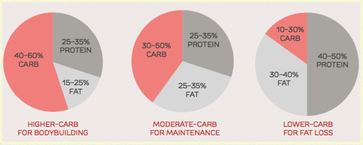
Nutrients, Micro- and Macro- nutrients (“macros”) are the building blocks of nutrition. Macros (carbohydrates, proteins and fats) are needed in large amounts, providing the body with the calories needed to function correctly. Micronutrients (vitamins and minerals), although are essential for health, they do not provide calories but rather the traces needed to function.
Carbohydrate + Protein + Fat = Total Calories -> +INFO "Calories to Nutrients"
Counting nutrients
What's the right macro's counting/proportion?
We need to consume a certain amount of each macro within a range. This flexibility allow us to pick the eating habits that better suits our needs, food preferences, and health goals. The USDA recommend us the following ranges for:
body maintenance: Carbohydrate: 30-50 percent Protein: 25-35 percent Fat: 25 - 35 percent
weight loss: Carbohydrate: 10-30 percent Protein: 40 - 50 percent Fat: 30 - 40 percent
body building: Carbohydrate: 40-60 percent Protein: 25-35 percent Fat: 15-25 percent
Interestingly, you can still plan your macros for different outcomes. Eating fewer carbs and more protein may help losing weight. As first step, you could try aiming for the lower end of the maintenance range for carbohydrates. (Note: You can download our app "Calorie Breaker" to make this calculations easy for you, based on your particular situation). Or, if you are a bodybuilder or aim for an intense training, you can go for a higher percentage of carbs.
Quality vs quantity
Keep in mind that because most foods contain a mix of carbs, proteins and fats, one can not completely cut one macro from the diet. Quality wins over quantity when it comes to health, so better not to get obsessed about measuring macros so that you miss out the nutrients that the body really needs. Warning: Be aware that people following those popular "miracle diets" often do not take into account what is healthy and what is not.
Even if you are not an athlete or sport professional it is still smart to see where your numbers fall. Adding fruits, veggies, whole grains, healthy fats, and lean protein on your plate is the most important thing, and balancing nutrients is just one more step to a achieving a healthy life style.
Not sure about your daily habits?
The food logging feature of the Fitbit app estimates your macronutrients when logging items from the food database. At the end the day you will be able to estimate your daily totals as percentages, and in grams. This makes your goal ratio of carbs, proteins and fat much easier in order to build a balanced diet. So try food logging for a few days to see how your macros measure up so that you know if you are more likely to lose, gain or maintain your weight ;-)
Related articles
Recommended in-house apps

















Write a comment